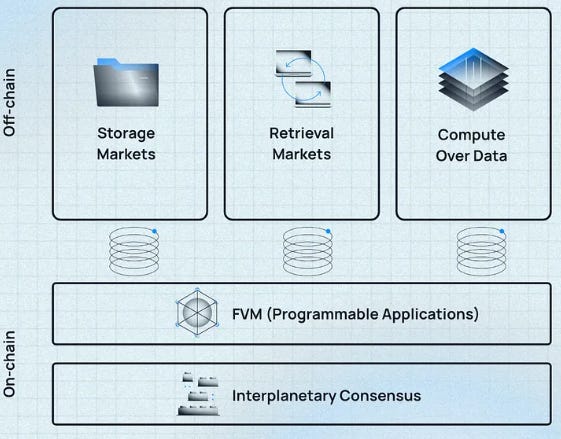Enter Filecoin
An excerpt from The Holon Data Report, Part 6
Filecoin, the invention of Stanford graduate Juan Benet (Figure 1) is a peer-to-peer cloud storage network designed to incentivise participants to store data reliably over time using a blockchain and its native currency, FIL. While the InterPlanetary File System(IPFS) is a protocol for peer-to-peer sharing and storing of data, it doesn’t natively include an economic incentive for storing someone else’s data. This is where Filecoin comes in.
Filecoin and IPFS are complementary protocols. IPFS – also a Benet invention – allows for decentralised and distributed storage of data, with files addressed by their content rather than location. However, while IPFS excels at distributing and retrieving data, it doesn’t incentivise users to store data they aren’t personally interested in thus IPFS itself isn’t robust for many applications.
The three core functions of data can be simplified down to storing it, moving it, and transforming it. These functions are fundamental to the operation of any data system, including the Filecoin Network.
Figure 1: Filecoin, IPFS and Protocol Labs founder Juan Benet
 Source: dribbble.com
Source: dribbble.com
Filecoin addresses the first by creating a marketplace for storage. It provides economic incentives (in the form of Filecoin tokens) for users to act as Storage Providers, offering their storage capacity to the network. In this way, Filecoin can be seen as an incentive layer built on top of IPFS, encouraging more users to participate in the storage and preservation of data on the network.
In simpler terms, Filecoin can be likened to the Airbnb of cloud storage, just as Airbnb leverages the combined capacity of homeowners globally to rival large hotel chains, Filecoin aggregates the storage capabilities of multiple network participants to compete with traditional cloud Storage Providers. Each individual Storage Provider on Filecoin is akin to an Airbnb homeowner, and the collective network mirrors Airbnb as a platform. By harnessing this distributed capacity, Filecoin can offer a decentralised, resilient, and economically rewarding alternative to centralised data storage services.
It’s important that readers also understand upfront that while much of the discussion regarding Filecoin is focused on storage aspect it is rapidly developing complementary services like the recently launched Filecoin Virtual machine (FVM ), Saturn (A decentralised CDN Network) and compute over data networks like Bacalhau. Further tooling and application services around the Filecoin protocol will continue to advance providing additional utility beyond these core functions. In this way Filecoin is evolving in a similar fashion to how many of the large cloud providers have today, providing core services with additional tooling and services evolving over time. These ancillary services are critical in the value proposition of Filecoin and its ability to compete with the large cloud players that dominate the internet today. Filecoin today has a three-phase ‘masterplan’, which consists of scalable data storage, massive data onboarding, and bringing utility to that data.
Storage – the base layer
Because of the Airbnb analogy above which is widely adopted, many people believe that the Filecoin Network is for spare capacity or for the hobbyist. While this may be a potential future state (Filecoin Station), today it requires a significant investment in enterprise level hardware (storage and compute).
The Filecoin Network’s rules are enforced by the blockchain. In some ways the Filecoin blockchain can be thought of as an audit and payment system, as it records the transactions, ensures the data is being stored as agreed and pays out distributions in FIL.
In the Filecoin Network, Storage Providers (referred to as ‘miners’) are required to periodically submit proofs to verify that they are correctly storing the data they have committed to store. This is an essential feature that ensures the reliability and integrity of the decentralised network. There are two main types of proofs that Storage Providers must submit:
Proof of Replication (PoRep): This is a proof that the Storage Provider has created a unique copy of the client’s data. The uniqueness is important to ensure that the provider is actually dedicating storage space to the data, rather than just storing one copy and claiming to store multiple copies. PoRep is submitted when the storage deal is made.
Proof of Spacetime (PoSt): This is a proof that the Storage Provider is continuing to store the client’s data over time. It’s not enough for the provider to simply create a replica of the data; they need to keep storing it for the duration of the storage deal. PoSt is submitted periodically throughout the lifetime of the storage deal These proofs are designed to be efficient to verify, even though they might be computationally intensive to produce. This asymmetry is important because it allows the network to efficiently check the work of many Storage Providers without requiring an excessive amount of computational resources.
The proofs form the foundation of Filecoin and act as a robust and importantly a verifiable storage layer upon which data services can than build upon. This leads us to the two other core ‘off-chain’ function of data on Filecoin; Retrieval Markets (Saturn) and Compute (Figure 2).
Figure 2: Filecoin layers
 Source Filecoin Foundation
Source Filecoin Foundation
The Holon Data Report Part 6, in its entirety, can be found here.
Disclaimer: This Article has been prepared by Holon Global Investments Limited ABN 60 129 237 592. Holon Global Innovations Pty Ltd (“HGI”) is a wholly owned subsidiary of Holon Global Investments Limited (together “Holon”). HGI is a Filecoin (FIL) Storage Provider and is positioned as a major player in the FIL decentralised data storage arena. FIL Storage Providers are rewarded in FIL for the provision of data storage capacity. Holon, its officers, employees and agents believe that the information in this material and the sources on which the information is based (which may be sourced from third parties) are correct as at the date of publication. While every care has been taken in the preparation of this material, no warranty of accuracy or reliability is given and no responsibility for this information is accepted by Holon, its officers, employees or agents. Except where contrary to law, Holon excludes all liability for this information.





